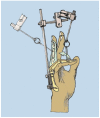A Personalized Approach to Treat Advanced Stage Severely Contracted Joints in Dupuytren's Disease with a Unique Skeletal Distraction Device-Utilizing Modern Imaging Tools to Enhance Safety for the Patient
- PMID: 35330378
- PMCID: PMC8953560
- DOI: 10.3390/jpm12030378
A Personalized Approach to Treat Advanced Stage Severely Contracted Joints in Dupuytren's Disease with a Unique Skeletal Distraction Device-Utilizing Modern Imaging Tools to Enhance Safety for the Patient
Abstract
Background: While surgical therapy for Dupuytren's disease is a well-established standard procedure, severe joint flexion deformities in advanced Dupuytren's disease remain challenging to treat. Skeletal distraction has proven to be an additional treatment option.
Methods: We analyzed the surgical treatment algorithm, including the application of a skeletal distraction device, in patients with a flexion deformity due to Dupuytren's disease, Iselin stage III or IV, who were operated on from 2003 to 2020 in our department.
Results: From a total of 724 patients, we included the outcome of 55 patients' fingers in this study, who had undergone additional skeletal joint distraction with our Erlangen device. Additional fasciotomy or fasciectomy, in a one- or two-staged procedure, was performed in all patients, according to the individual findings and necessities. The range of motion of the PIP joint improved from 12° to 53°. A number of complications, in all steps of the treatment, were noted in a total of 36.4% of patients, including the development of fractures (16.4%), followed by vessel injury, pin infections, and complex regional pain syndrome (5%).
Conclusions: Additional skeletal distraction improves the range of motion of severely contracted joints in Dupuytren's disease. Nevertheless, careful patient selection is necessary, due to the moderate rate of complications.
Keywords: Dupuytren contracture; distracted driving; joint dislocation.
Conflict of interest statement
The authors declare no conflict of interest.
Figures









References
LinkOut - more resources
Full Text Sources

